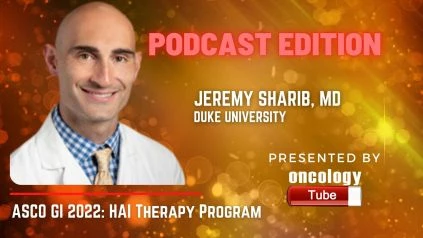Jeremy Sharib, MD, Complex General Surgical Oncology Fellow at Duke University. In this interview, he speaks about ASCO GI 2022 Abstract – Perioperative and oncologic outcomes of hepatic artery infusion pump therapy at an expanding HAI program.
Origins:
Unresectable or resected colorectal liver metastases (CRLM) and unresectable intrahepatic cholangiocarcinoma are treated with hepatic artery infusion (HAI) (ICC). Historically, HAI was only performed at a few specialist sites; now, the number of new centers is growing. We recently discussed the safety results of our first year of HAI therapy. We now have results for an enlarged cohort of 62 patients in an established HAI program, including safety, feasibility, efficacy, and oncologic outcomes.
Methodologies:
Patients were assessed for demographics and perioperative outcomes after being selected for HAI through a multidisciplinary assessment. RECIST 1.1 was used to calculate the objective liver response. The Kaplan-Meier method was used to determine hepatic and extrahepatic progression-free survival (PFS) on an intent-to-treat basis.
Findings:
From November 2018 to September 2021, 62 patients were treated with HAI: 46 for unresectable CRLM, 8 as adjuvant HAI for resected CRLM, and 8 for unresectable ICC. The median age was 54.5 years (range 32-80), 58 percent of the participants were men, and 97 percent had previously had chemotherapy (median 12 cycles, range 0-66). Hepatectomy (18, 29 percent) and/or colectomy/proctectomy (27, 43.5 percent) were done at the same time as pump insertion, with 19 (30.6 percent) done robotically. The average operating duration was 265 minutes (range 130-526), with an estimated blood loss of 100 mL (range 22-1000) and a 5-day stay (range 1-19). In 14% of cases, HAI-related problems occurred (Table). Floxuridine (FUDR) was started in 95 percent of patients 18.5 days following surgery on average. Hepatic disease control was obtained in 86 percent (8 partial responses [PR], 22 stable disease [SD], 5 progressed [PD]), and 89 percent (1 complete response, 8 PR, 8 SD, 2 PD) of the 38 patients who underwent HAI for unresectable CRLM and had measurable disease on imaging. The median PFS, hepatic PFS, and extrahepatic PFS were 13 months, 13 months, and 13 months, respectively, for patients with at least 3 months of follow-up.
Outcomes:
HAI can be given to well-selected patients with CRLM and ICC in a safe and effective manner. New programs with adequate expertise can achieve response rates, disease control, and PFS in highly treated patients with unresectable CRLM that are equivalent to high-volume facilities. These findings back up the newly founded HAI Consortium’s objective of critically evaluating efficacy and innovation in HAI therapy through multi-institutional collaboration and modern prospective studies.

